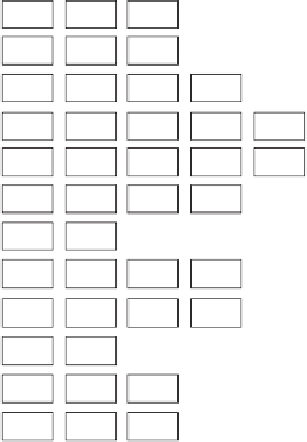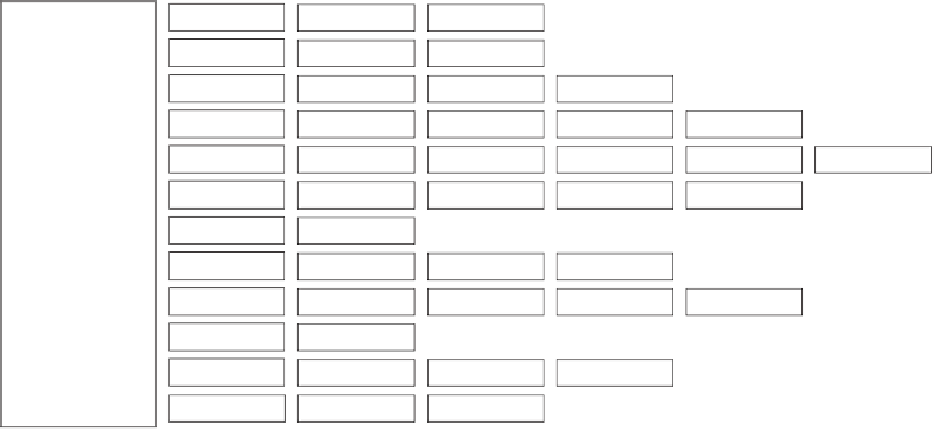Java Reference
In-Depth Information
neighbors[0]
Seattle
1
3
5
neighbors[1]
San Francisco
0
2
3
neighbors[2]
Los Angeles
1
3
4
10
Denver
neighbors[3]
neighbors[4]
0
1
2
4
5
Kansas City
2
3
5
7
8
10
Chicago
neighbors[5]
0
3
4
6
7
neighbors[6]
Boston
5
7
New York
neighbors[7]
4
5
6
8
neighbors[8]
Atlanta
4
7
9
10
11
Miami
neighbors[9]
8
11
neighbors[10]
Dallas
2
4
8
11
neighbors[11]
Houston
8
9
10
F
IGURE
28.6
Edges in the graph in Figure 28.1 are represented using adjacency vertex lists.
neighbors[0]
neighbors[1]
Edge(0, 1)
Edge(0, 3)
Edge(0, 5)
Seattle
San Francisco
Edge(1, 0)
Edge(1, 2)
Edge(1, 3)
neighbors[2]
Los Angeles
Edge(2, 1)
Edge(2, 3)
Edge(2, 4)
Edge(2, 10)
neighbors[3]
neighbors[4]
Denver
Edge(3, 0)
Edge(3, 1)
Edge(3, 2)
Edge(3, 4)
Edge(3, 5)
Kansas City
Edge(4, 2)
Edge(4, 3)
Edge(4, 5)
Edge(4, 7)
Edge(4, 8)
Edge(4, 10)
neighbors[5]
Chicago
Edge(5, 0)
Edge(5, 3)
Edge(5, 4)
Edge(5, 6)
Edge(5, 7)
neighbors[6]
neighbors[7]
Boston
Edge(6, 5)
Edge(6, 7)
New York
Edge(7, 4)
Edge(7, 5)
Edge(7, 6)
Edge(7, 8)
neighbors[8]
Atlanta
Edge(8, 4)
Edge(8, 7)
Edge(8, 9)
Edge(8, 10)
Edge(8, 11)
neighbors[9]
neighbors[10]
Miami
Edge(9, 8)
Edge(9, 11)
Dallas
Edge(10, 2)
Edge(10, 4)
Edge(10, 8)
Edge(10, 11)
neighbors[11]
Houston
Edge(11, 8)
Edge(11, 9)
Edge(11, 10)
F
IGURE
28.7
Edges in the graph in Figure 28.1 are represented using adjacency edge lists.
Note
Adjacency vertex list is simpler for representing unweighted graphs. However, adjacency
edge lists are more flexible for a wide range of graph applications. It is easy to add addi-
tional constraints on edges using adjacency edge lists. For this reason, this topic will use
adjacency edge lists to represent graphs.
adjacency vertex list vs.
adjacency edge lists
You can use arrays, array lists, or linked lists to store adjacency lists. We will use lists
instead of arrays, because the lists are easily expandable to enable you to add new vertices.
Further we will use array lists instead of linked lists, because our algorithms only require
searching for adjacent vertices in the list. Using array lists is more efficient for our algorithms.
Using array lists, the adjacency edge list in Figure 28.6 can be built as follows:
using ArrayList
List<ArrayList<Edge>> neighbors =
new
ArrayList<>();
neighbors.add(
new
ArrayList<Edge>());
neighbors.get(
0
).add(
new
Edge(
0
,
1
));










































Search WWH ::

Custom Search